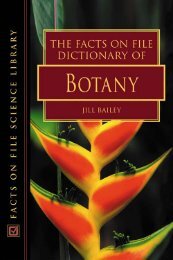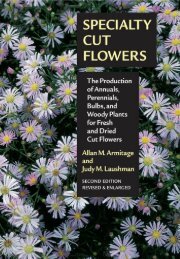Create successful ePaper yourself
Turn your PDF publications into a flip-book with our unique Google optimized e-Paper software.
7.4 I'neumatophores of Alliceimia ni/ida (mangrove)<br />
growing in saline estuarine mud. The negatively geotropic<br />
roOIS of this dicotyledon develop from long horizontal<br />
roors which extend from the base of (he tree Irunk and<br />
grow in the oxygen-depleted mud. The breathing rools are<br />
protected by a cork covering but contain many lenricels to<br />
allow aerarion of the horiz.onral root system.<br />
136<br />
7.5 TS of a small pneumarophore of the dicotyledon<br />
AIJiunnia nitida (mangrove). This negatively geotropic root<br />
(d., 7.4) is covered by cork (I) concaining numerous<br />
lenticels. The numerous cortical sdereids (2) support the<br />
parenchyma cells which are separated by extensive<br />
intercellular spaces (3) providing aeration lO me submerged<br />
horizontal roots. Cork cambium (4), endodermis {51,<br />
.sa.:ondary phloem (6), secondary xylem (7). (L\i x 70.)<br />
I Cork<br />
2 Cortical sclereids<br />
3 Intercellular spaces<br />
4 Cork cambium<br />
5 Endodermis<br />
6 Secomlary phloem<br />
7 Secondary xylem<br />
7.6 Rhiwphora mangle (spider n1:ln·<br />
grove) growing in saline estuarine mud.<br />
These dicocyledons show a densc tangle of<br />
adventitious stilt roots which help to<br />
stabilise the tree and transpon water and<br />
nutrients to its trunk. Although covered by<br />
bark, numerous lenricds in the stilts allow<br />
aeration of Ihe roots growing in the<br />
oxygen-depleted mud. In the foreground<br />
sc,·eral seedlings, which germinated in the<br />
fruits while srill anached to the tree, have<br />
fallen into the mud and starred to grow.





